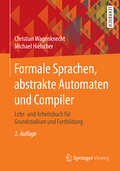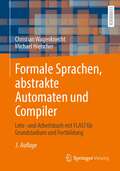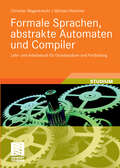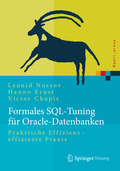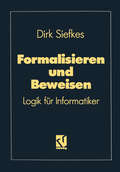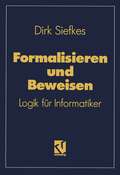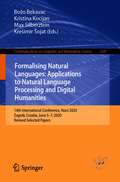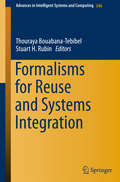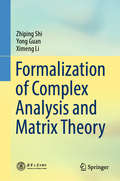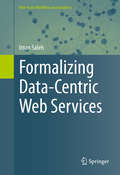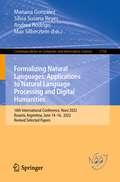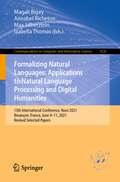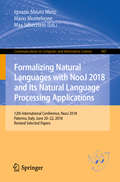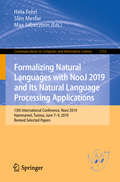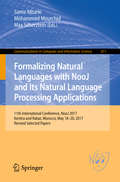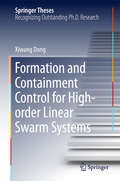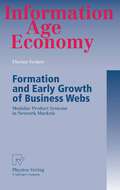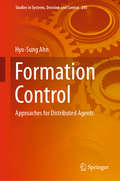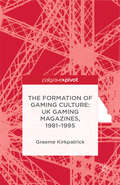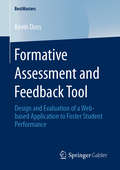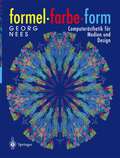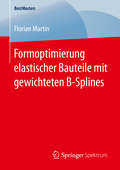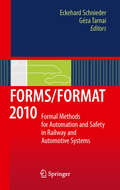- Table View
- List View
Formale Sprachen, abstrakte Automaten und Compiler: Lehr- und Arbeitsbuch für Grundstudium und Fortbildung
by Christian Wagenknecht Michael HielscherDie eher abstrakten Inhalte der Theoretischen Informatik werden aus praktischen Anwendungsbeispielen heraus motiviert, anschaulich vermittelt und in Übungen vertieft. Durch das gesamte Buch hindurch zieht sich das Vorhaben, einen Compiler für eine Sprache mit grafischen Effekten herzustellen. An den entsprechenden Stellen werden die dafür notwendigen Beiträge erarbeitet und Aspekte automatisierter Compilergenerierung thematisiert. Zur Modellierung formaler Sprachen, regulärer Ausdrücke, abstrakter Automaten und zur automatisierten Compilergenerierung aus einer grafisch-visuellen Beschreibung stellt AtoCC miteinander vernetzte Komponenten zur Verfügung. Die Lern- und Arbeitsumgebung AtoCC wurde speziell für das Studium der theoretischen Informatik entwickelt und bereits an mehreren Hochschulen und Schulen erfolgreich eingesetzt. AtoCC vertieft Theoriewissen durch praktische Übungen und attraktive Anwendungsprojekte aus dem Grafik- und Audiobereich. Übersetzung und Verarbeitung mehr oder weniger komplexer Sprachen finden wir heute beispielsweise auch in modernen Web-Applikationen.
Formale Sprachen, abstrakte Automaten und Compiler: Lehr- und Arbeitsbuch mit FLACI für Grundstudium und Fortbildung
by Christian Wagenknecht Michael HielscherDie eher abstrakten Inhalte der Theoretischen Informatik werden aus praktischen Anwendungsbeispielen heraus motiviert, anschaulich vermittelt und in Übungen vertieft. Durch das gesamte Buch hindurch zieht sich das Vorhaben, einen Compiler für eine Sprache mit grafischen Effekten herzustellen. An den entsprechenden Stellen werden die dafür notwendigen Beiträge erarbeitet und Aspekte automatisierter Compilergenerierung thematisiert. Zur Definition und Simulation formaler Sprachen mit regulären Ausdrücken, formalen Grammatiken und abstrakten Automaten sowie zur automatisierten Compilergenerierung aus einer grafisch-visuellen Beschreibung stellt die Lern- und Arbeitsumgebung FLACI miteinander vernetzte Komponenten zur Verfügung. Da es sich um eine Web-Anwendung (ohne JAVA) handelt, entfällt jeglicher Installations- und Aktualisierungsaufwand. FLACI wurde speziell für das Studium der theoretischen Informatik entwickelt und bereits an mehreren Hochschulen und Schulen erfolgreich eingesetzt. FLACI vertieft Theoriewissen durch praktische Übungen und attraktive Anwendungsprojekte aus dem Grafik- und Audiobereich. Übersetzung und Verarbeitung mehr oder weniger komplexer Sprachen finden wir heute beispielsweise auch in modernen Web-Applikationen.
Formale Sprachen, abstrakte Automaten und Compiler: Lehr- und Arbeitsbuch für Grundstudium und Fortbildung
by Christian Wagenknecht Michael HielscherDie eher abstrakten Inhalte der Theoretischen Informatik werden aus praktischen Anwendungsbeispielen heraus motiviert, vermittelt und in Übungen mit Anwendungsbezug vertieft. Dabei werden vor allem Aspekte automatisierter Compilergenerierung thematisiert. Übersetzung und Verarbeitung mehr oder weniger komplexer Sprachen finden wir heute beispielsweise in modernen Web-Applikationen. Es gibt vielfältige sehr interessante Beispiele auch im Grafik- und Audiobereich, die sich durch "Belebung" abstrakter Konzepte umsetzen lassen. Die Lern- und Arbeitsumgebung AtoCC hilft dabei, zu attraktiven lauffähigen Programmen zu kommen.
Formales SQL-Tuning für Oracle-Datenbanken: Praktische Effizienz - effiziente Praxis (Xpert.press)
by Leonid Nossov Hanno Ernst Victor ChupisDas Ziel des SQL-Tunings ist eine Verbesserung des bestehenden Ausführungsplans. Die in diesem Buch beschriebene Methode kann man „Bremsenbeseitigung im Ausführungsplan“ nennen. Solche „Bremsen“ oder Engpässe lassen sich durch eine formale Analyse des Ausführungsplans erkennen. Dafür sind keine Datenmodellkentnisse notwendig. Das ist besonders vorteilhaft für Datenbankadministratoren, weil sie in der Regel gar nicht oder unzureichend gut mit dem Datenmodell vertraut sind. Im Buch werden zahlreiche praktische Erfahrungen mit dieser Methode präsentiert.
Formalisieren und Beweisen: Logik für Informatiker (Lehrbuch Informatik)
by Dirk SiefkesGregory Bateson -Biologe, Anthropologe, Psychiater, Systemtheoretiker -erzählt in der Ein l leitung zu seinem Buch Geist und Natur eine Geschichte: Ein Mann gibt in seinen Computer die Frage ein: "Wirst Du jemals denken wie ein Mensch? Rechne mal nach!" Der Computer rechnet und rechnet und gibt schließlich aus: Dabei fallt mir eine Geschichte ein. Die Geschichte dieses Buches handelt von Menschen. "Fangt doch jeden Abschnitt mit einem Beispiel an", schlug Ralf-Detlef Kutsche vor, als er mir 1982 zusammen mit Peter Padawitz, Simone Pribbenow und Andreas Schulze half, die Lehrveranstaltung Logik für Informatiker durchzuführen. "Fragen und Aufgaben regen besser zum Arbeiten an als Begriffe und Sätze. " Deswegen beginnt jeder Teil dieses Buches mit einer Geschichte, die als Arbeitsmaterial dient: Die Einführung mit dem Problem des Affen mit der Banane, die Aussagenlogik mit der Ballwurf logelei, die Offene Prädikatenlogik mit dem Architektenbeispiel und die volle Prädikatenlogik mit der Geometrie Euklids. Deswegen endet jeder Abschnitt mit Aufgaben und Fragen, die wesentlich fürs Verstehen sind. Deswegen sieht man beim Blättern so wenig Beweise: Ich ent wickle einen Beweis lieber aus einer Fragestellung und formuliere das Ergebnis als Satz, statt mit dem Satz zu beginnen. Deswegen sind die Themen des Buches Formalisieren und Verstehen, Tätigkeiten, und nicht Logik und Informatik, Gebiete. Ich behandle in dem Buch im wesentlichen die klassischen Grundthemen der mathematischen Logik: logische Folgerung, Ableitung, Vollständigkeit, logische Theorie, Axiomensystem. Es geht mir aber nicht darum, diese Begriffe und ihre Eigenschaften darzustellen.
Formalising Natural Languages: 14th International Conference, NooJ 2020, Zagreb, Croatia, June 5–7, 2020, Revised Selected Papers (Communications in Computer and Information Science #1389)
by Božo Bekavac Kristina Kocijan Max Silberztein Krešimir ŠojatThis book constitutes selected revised papers of the 14th International Conference, NooJ 2020, held Zagreb, Croatia, in June 2020. Due to the COVID-19 pandemic the conference was held online. NooJ is a linguistic development environment that allows linguists to formalize several levels of linguistic phenomena. NooJ provides linguists with tools to develop dictionaries, regular grammars, context-free grammars, context-sensitive grammars and unrestricted grammars as well as their graphical equivalent to formalize each linguistic phenomenon. The 20 full papers presented were carefully reviewed and selected from 68 submissions. The papers are organized in the following topics: Linguistic Formalization; Digital Humanities and Teaching with NooJ; Natural Language Processing Applications.
Formalisms for Reuse and Systems Integration (Advances in Intelligent Systems and Computing #346)
by Thouraya Bouabana-Tebibel Stuart H. RubinReuse and integration are defined as synergistic concepts, where reuse addresses how to minimize redundancy in the creation of components; while, integration focuses on component composition. Integration supports reuse and vice versa. These related concepts support the design of software and systems for maximizing performance while minimizing cost. Knowledge, like data, is subject to reuse; and, each can be interpreted as the other. This means that inherent complexity, a measure of the potential utility of a system, is directly proportional to the extent to which it maximizes reuse and integration. Formal methods can provide an appropriate context for the rigorous handling of these synergistic concepts. Furthermore, formal languages allow for non ambiguous model specification; and, formal verification techniques provide support for insuring the validity of reuse and integration mechanisms. This edited book includes 12 high quality research papers written by experts in formal aspects of reuse and integration to cover the most recent advances in the field. These papers are extended versions of some of the best papers, which were presented at the IEEE International Conference on Information Reuse and Integration and the IEEE International Workshop on Formal Methods Integration - both of which were held in San Francisco in August 2014.
The Formalisms of Quantum Mechanics: An Introduction (Lecture Notes in Physics #893)
by Francois DavidThese lecture notes present a concise and introductory, yet as far as possible coherent, view of the main formalizations of quantum mechanics and of quantum field theories, their interrelations and their theoretical foundations.The “standard” formulation of quantum mechanics (involving the Hilbert space of pure states, self-adjoint operators as physical observables, and the probabilistic interpretation given by the Born rule) on one hand, and the path integral and functional integral representations of probabilities amplitudes on the other, are the standard tools used in most applications of quantum theory in physics and chemistry. Yet, other mathematical representations of quantum mechanics sometimes allow better comprehension and justification of quantum theory. This text focuses on two of such representations: the algebraic formulation of quantum mechanics and the “quantum logic” approach. Last but not least, some emphasis will also be put on understanding the relation between quantum physics and special relativity through their common roots - causality, locality and reversibility, as well as on the relation between quantum theory, information theory, correlations and measurements, and quantum gravity.Quantum mechanics is probably the most successful physical theory ever proposed and despite huge experimental and technical progresses in over almost a century, it has never been seriously challenged by experiments. In addition, quantum information science has become an important and very active field in recent decades, further enriching the many facets of quantum physics. Yet, there is a strong revival of the discussions about the principles of quantum mechanics and its seemingly paradoxical aspects: sometimes the theory is portrayed as the unchallenged and dominant paradigm of modern physical sciences and technologies while sometimes it is considered a still mysterious and poorly understood theory, waiting for a revolution. This volume, addressing graduate students and seasoned researchers alike, aims to contribute to the reconciliation of these two facets of quantum mechanics.
Formalization of Complex Analysis and Matrix Theory
by Zhiping Shi Yong Guan Ximeng LiThis book discusses the formalization of mathematical theories centering on complex analysis and matrix theory, covering topics such as algebraic systems, complex numbers, gauge integration, the Fourier transformation and its discrete counterpart, matrices and their transformation, inner product spaces, and function matrices. The formalization is performed using the interactive theorem prover HOL4, chiefly developed at the University of Cambridge. Many of the developments presented are now integral parts of the library of this prover.As mathematical developments continue to gain in complexity, sometimes demanding proofs of enormous sizes, formalization has proven to be invaluable in terms of obtaining real confidence in their correctness. This book provides a basis for the computer-aided verification of engineering systems constructed using the principles of complex analysis and matrix theory, as well as building blocks for the formalization of more involved mathematical theories.
Formalizing Data-Centric Web Services (Web-Scale Workflow and Analytics)
by Iman SalehThis book presents a methodology to model and specify the data aspect of Web services, as it is overlooked by current standards for specifying Web services. The formal specification enables verification of service behavior, and the proposed methodology is based on formal methods and design-by-contract techniques. The Web has evolved from an information sharing medium to a wide-scale environment for sharing capabilities or services. Currently, URLs not only point to documents and images, but are also used to invoke services that potentially change the state of the Web. Major online organizations today, such as Amazon, PayPal and FedEx, provide services for users and consumers. They also allow third-party vendors to resell their services. In both cases, this requires precise and complete specification of service offerings. Several online discussions demonstrate the challenges faced by these organizations and others while describing their data-centric Web services. These challenges surrounding data specification can lead consumers to use a service erroneously. Case studies demonstrate how formal methods, and specifically design-by-contract techniques, can be leveraged to address the lack of formal specification of data when it comes to developing Web applications such as Amazon and PayPal.
Formalizing Natural Languages: 16th International Conference, NooJ 2022, Rosario, Argentina, June 14–16, 2022, Revised Selected Papers (Communications in Computer and Information Science #1758)
by Mariana González Silvia Susana Reyes Andrea Rodrigo Max SilberzteinThis book constitutes selected revised papers of the 16th International Conference on Formalizing Natural Languages: Applications to Natural Language Processing and Digital Humanities, NooJ 2022, held in Rosario, Argentina, in June 2022. Due to COVID-19 pandemic the conference was held virtually.NooJ is a linguistic development environment that provides tools for linguists to construct linguistic resources that formalize a large gamut of linguistic phenomena: typography, orthography, lexicons for simple words, multiword units and discontinuous expressions, inflectional, derivational and agglutinative morphology, local, phrase-structure and dependency grammars, as well as transformational and semantic grammars.The 17 full papers presented were carefully reviewed and selected from 50 submissions. The papers are organized in the following topics: Morphological and Lexical Resources; Syntactic and Semantic Resources; Corpus Linguistics and Discourse Analysis; Natural Language Processing Applications.
Formalizing Natural Languages: 15th International Conference, NooJ 2021, Besançon, France, June 9–11, 2021, Revised Selected Papers (Communications in Computer and Information Science #1520)
by Max Silberztein Magali Bigey Annabel Richeton Izabella ThomasThis book constitutes selected revised papers of the 15th International Conference, NooJ 2021, held in Besançon, France, in June 2021. Due to the COVID-19 pandemic the conference was held online. NooJ is a linguistic development environment that allows linguists to formalize several levels of linguistic phenomena. NooJ provides linguists with tools to develop dictionaries, regular grammars, context-free grammars, context-sensitive grammars and unrestricted grammars as well as their graphical equivalent to formalize each linguistic phenomenon. The 20 full papers presented were carefully reviewed and selected from 62 submissions. The papers are organized in the following topics: linguistic formalization and analysis, digital humanities and teaching, natural language processing applications.
Formalizing Natural Languages with NooJ 2018 and Its Natural Language Processing Applications: 12th International Conference, NooJ 2018, Palermo, Italy, June 20–22, 2018, Revised Selected Papers (Communications in Computer and Information Science #987)
by Max Silberztein Mario Monteleone Ignazio Mauro MirtoThis book constitutes the refereed proceedings of the 12th International Conference, NooJ 2018, held in Palermo, Italy, in June 2018.The 17 revised full papers and 3 short papers presented in this volume were carefully reviewed and selected from 48 submissions. NooJ is a linguistic development environment that provides tools for linguists to construct linguistic resources that formalize a large gamut of linguistic phenomena: typography, orthography, lexicons for simple words, multiword units and discontinuous expressions, inflectional and derivational morphology, local, structural and transformational syntax, and semantics. The papers in this volume are organized in topical sections on vocabulary and morphology; syntax and semantics; and natural language processing applications.
Formalizing Natural Languages with NooJ 2019 and Its Natural Language Processing Applications: 13th International Conference, NooJ 2019, Hammamet, Tunisia, June 7–9, 2019, Revised Selected Papers (Communications in Computer and Information Science #1153)
by Héla Fehri Slim Mesfar Max SilberzteinThis book constitutes the refereed proceedings of the 13th International Conference, NooJ 2019, held in Hammamet, Tunisia, in June 2019. NooJ is a linguistic development environment that allows linguists to formalize several levels of linguistic phenomena. NooJ provides linguists with tools to develop dictionaries, regular grammars, context-free grammars, context-sensitive grammars and unrestricted grammars as well as their graphical equivalent to formalize each linguistic phenomenon. The 18 full papers presented were carefully reviewed and selected from 54 submissions. The papers are organized in the following tracks: Development of Linguistic Resources, Natural Language Processing Applications, NooJ for the Digital Humanities.
Formalizing Natural Languages with NooJ and Its Natural Language Processing Applications: 11th International Conference, NooJ 2017, Kenitra and Rabat, Morocco, May 18–20, 2017, Revised Selected Papers (Communications in Computer and Information Science #811)
by Samir Mbarki Mohammed Mourchid Max SilberzteinThis book constitutes the refereed proceedings of the 11th International Conference, NooJ 2017, held in Kenitra and Rabat, Morocco, in May 2017. The 20 revised full papers presented in this volume were carefully reviewed and selected from 56 submissions. NooJ is a linguistic development environment that provides tools for linguists to construct linguistic resources that formalize a large gamut of linguistic phenomena: typography, orthography, lexicons for simple words, multiword units and discontinuous expressions, inflectional and derivational morphology, local, structural and transformational syntax, and semantics. The papers in this volume are organized in topical sections on vocabulary and morphology; syntactic analysis; natural language processing applications; NooJ’s future.
Formation and Containment Control for High-order Linear Swarm Systems (Springer Theses)
by Xiwang DongThis book focuses on analysis and design problems for high-order linear time-invariant (LTI) swarm systems (multi-agent systems) to achieve consensus, formation, containment and formation-containment. As a first step, the concepts of practical consensus and formation-containment are introduced. Unlike previous research, the formation in this book can be time-varying. A general framework for consensus, consensus tracking, formation, containment and state formation-containment is presented for the first time.Sufficient/necessary and sufficient conditions, and approaches to designing the protocols for swarm systems to achieve these control objectives, are respectively proposed. Autonomous time-varying formation experiments using five quadrotor unmanned aerial vehicles (UAVs) are conducted in an outdoor setting to demonstrate the theoretical results.
Formation and Early Growth of Business Webs: Modular Product Systems in Network Markets (Information Age Economy)
by Florian SteinerNetworks of firms have been in the focus of management research for several years. Recently, special attention has been paid to so-called business webs. Business webs are networks of firms which provide complements to a common product architecture. In the past, research focused on management issues of such webs but neglected the important question of how they actually came into being. The present book explicitly examines the formation and early growth of business webs. The author illustrates the early growth phases with two in-depth cases of the formation of the wireless internet ecosystem i-mode and the leading person-to-person online auction platform eBay. The book uncovers the contingencies under which the establishment of business webs is likely to succeed. Business researchers will benefit from the theoretical framework, while interested business managers will find explanations and advice for establishing a business web.
Formation Control: Approaches for Distributed Agents (Studies in Systems, Decision and Control #205)
by Hyo-Sung AhnThis monograph introduces recent developments in formation control of distributed-agent systems. Eschewing the traditional concern with the dynamic characteristics of individual agents, the book proposes a treatment that studies the formation control problem in terms of interactions among agents including factors such as sensing topology, communication and actuation topologies, and computations. Keeping pace with recent technological advancements in control, communications, sensing and computation that have begun to bring the applications of distributed-systems theory out of the industrial sphere and into that of day-to-day life, this monograph provides distributed control algorithms for a group of agents that may behave together. Unlike traditional control laws that usually require measurements with respect to a global coordinate frame and communications between a centralized operation center and agents, this book provides control laws that require only relative measurements and communications between agents without interaction with a centralized operator. Since the control algorithms presented in this book do not require any global sensing and any information exchanges with a centralized operation center, they can be realized in a fully distributed way, which significantly reduces the operation and implementation costs of a group of agents. Formation Control will give both students and researchers interested in pursuing this field a good grounding on which to base their work.
The Formation of Gaming Culture: UK Gaming Magazines, 1981-1995
by G. KirkpatrickThis book analyses gaming magazines published in Britain in the 1980s to provide the first serious history of the bedroom coding culture that produced some of the most important video games ever played.
Formative Assessment and Feedback Tool: Design and Evaluation of a Web-based Application to Foster Student Performance (BestMasters)
by Kevin DussIn this book, Kevin Duss tackles the well-known problem in the teaching structure of today’s universities that despite the immense potential of formative feedback towards students is not or only insufficiently applied. The author uses existing research and modern technologies to develop a web-based feedback application that enhances both objective and perceived student performance. This work makes a first step towards a design theory for formative feedback applications and gives guidance for their successful implementation.
Formative Assessment, Learning Data Analytics and Gamification: In ICT Education (Intelligent Data-Centric Systems: Sensor Collected Intelligence)
by Santi Caballé Robert ClarisóFormative Assessment, Learning Data Analytics and Gamification: An ICT Education discusses the challenges associated with assessing student progress given the explosion of e-learning environments, such as MOOCs and online courses that incorporate activities such as design and modeling. This book shows educators how to effectively garner intelligent data from online educational environments that combine assessment and gamification. This data, when used effectively, can have a positive impact on learning environments and be used for building learner profiles, community building, and as a tactic to create a collaborative team. Using numerous illustrative examples and theoretical and practical results, leading international experts discuss application of automatic techniques for e-assessment of learning activities, methods to collect, analyze, and correctly visualize learning data in educational environments, applications, benefits and challenges of using gamification techniques in academic contexts, and solutions and strategies for increasing student participation and performance. Indexing: The books of this series are submitted to EI-Compendex and SCOPUSDiscusses application of automatic techniques for e-assessment of learning activitiesPresents strategies to provide immediate and useful feedback on students’ activitiesProvides methods to collect, analyze, and correctly visualize learning data in educational environmentsExplains the applications, benefits, and challenges of using gamification techniques in academic contextsOffers solutions to increase students’ participation and performance while lowering drop-out rates and retention levels
Formel, Farbe, Form: Computerästhetik für Medien und Design
by Georg NeesTauchen Sie ein in die Welt der Computerkunst! Mit mehr als 200 Abbildungen und 83 Farbtafeln zeigt Ihnen das Buch, wie Sie graphisch-geometrische Programmiersysteme für Kunst, Design, Werbung und Wissenschaft realisieren.
Formoptimierung elastischer Bauteile mit gewichteten B-Splines (BestMasters)
by Florian MartinFlorian Martin verbindet verschiedene Verfahren mit einer auf gewichteten B-Splines basierenden Finite-Elemente-Methode, um die optimale Form eines elastischen Bauteils unter Krafteinwirkung zu ermitteln. Durch den Wegfall der Vernetzung und die hohe Genauigkeit und Glattheit der B-Splines werden bei der Variation des Gebietsrandes während der Optimierung massive Geschwindigkeitsvorteile erzielt. Darüber hinaus spielen B-Splines in vielen Bereichen der Naturwissenschaften und ihren zahlreichen Anwendungsgebieten, wie beispielsweise in der Computergrafik, eine fundamentale Rolle. Insbesondere bei Finite-Elemente-Verfahren bieten diese gegenüber klassischen Methoden zahlreiche Vorteile.
FORMS/FORMAT 2010: Formal Methods for Automation and Safety in Railway and Automotive Systems
by Eckehard Schnieder Geza TarnaiComplexity in automation- and safety systems in railway as well as automotive applications are dominated more and more by formal description means, methods and tools. Formal techniques provide next to correctness and integrity checkups – especially for safety relevant systems – the possibility to model, prove, simulate and check the specification of the system as well as to generate the system implementations. Requirements of the CENELEC- and IEC-Standards on formal techniques, particularly with regard to the handling of safety analysis, are to be treated in FORMS/FORMAT 2010. The main focus lies on topics facing formal techniques for railway applications and intelligent transportation systems as well as for automotive applications. Gained findings, experiences and also difficulties associated with the handling of the subject matter as well as description means and tools are to be shown.
